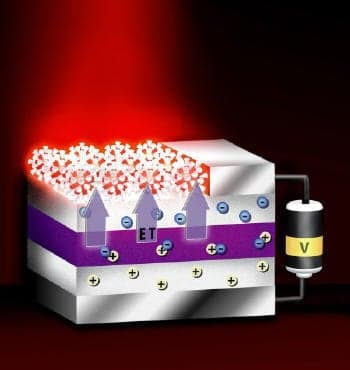Semiconductor nanocrystals (or quantum dots) are attractive for use in a number of light-emitting technologies. But there's a snag: it's hard to pump nanocrystals electrically because of their insulating organic capping layers. Now scientists at Los Alamos National Laboratory and Sandia National Laboratories, both in the US, have transferred energy to nanocrystals from epitaxial quantum wells without the need for electrical contacts (M Achermann et al. 2004 Nature 429 642).

The non-radiative energy transfer process indirectly injects electron-hole pairs into the nanocrystals. These later recombine, emitting light as a result.
“The high efficiency of energy transfer in combination with the exceptional luminescent properties of nanocrystal quantum dots make hybrid quantum-well/nanocrystal devices feasible as efficient sources of any colour light – or even white light,” said Victor Klimov of Los Alamos.
In this study the scientists chose to impart energy to the quantum well by optical pumping so that they could obtain additional information about how that energy then transferred to the nanocrystals. In real-life, however, they say they could also pump the quantum well electrically, in the same way that a common quantum-well light-emitting diode is pumped.
The researchers used a 3 nanometre indium-gallium-nitride quantum well underneath a monolayer of cadmium-selenium/zinc sulphide core/shell nanocrystals. The nanocrystals, which had a core radius of 1.9 nanometres and a shell thickness of around 0.6 nanometres, were capped with organic molecules.
Klimov and colleagues pumped the quantum well by shining laser light with a wavelength of 266 nanometres on the device. The well transferred its energy to the nanocrystals with an efficiency of around 55%. And, according to the researchers, the nanocrystal capping layer did not significantly inhibit the process.
“The transfer of energy is fast enough to compete with exciton — bound electron-hole pair — recombination in the quantum well, and that allows us to ‘move’ more than 50% of the excitons to adjacent quantum dots,” said Klimov. “The recombination of these transferred excitons leads to the emission of light with colour that can be controlled by quantum-dot size.”
What’s more, the researchers believe they may be able to achieve efficiencies of nearly 100% by improving the quality of the quantum wells to reduce non-radiative losses, and by optimizing the geometry of the nanocrystal/quantum-well structure. The scientists say that the technique could also find a use in nanocrystal-based optical amplifiers and lasers.



